
How to freeze Saskatoons to use later (directions, recipe, with photos and free)
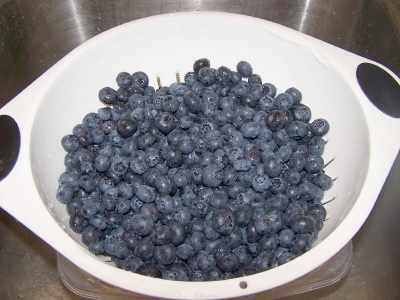
If you like saskatoons in the winter, for saskatoon pie (see this page for a great recipe), dessert, or just in a bowl; just imagine how good it would taste if you had picked a couple of quarts fresh or bought a them from a farm stand and then quickly froze them at home! It is also one of the simplest ways to put up a fruit for the winter. Here's how to do it, complete instructions in easy steps and completely illustrated. Your own frozen saskatoons will taste MUCH better than anything you've ever had from a store.
Directions for Freezing Saskatoons
(also saskatoons and huckelberries)
Ingredients
- fresh saskatoons - any quantity
Equipment
- a pan or tray that will fit in your freezer
- a strainer or colander
- Vacuum food sealer or "ziploc" type freezer bags (the freezer bag version is heavier and protects better against freezer burn.
Instructions
Step 1 - Get yer berries!
Start with the freshest saskatoons you can get. Look for plump,
full berries with a good color. I've used saskatoons as an example, but
these directions would equally well for any other berry (blackberries,
raspberries, saskatoons, etc.) See the
picking tips page for other
berries.
Step 2 - Sort the saskatoons.
Pick out and remove any bits of stems, leaves and soft or mushy saskatoons. One peculiarity about saskatoons that is different from other berries is, if you wash them before freezing, the skins become tougher. If you plan to use them later in cooking, I haven't found this to be a problem. Since I use the frozen saskatoons only to make saskatoon pie, saskatoon muffins and saskatoon pancakes in the dead of winter, the cooking softens them, anyway. But if you plan to use them uncooked after thawing, you might wait to wash them until AFTER you thaw them. If you are going to cook them later, just put them in a big bowl of water to wash and help sort out the berries!
If you plan not to wash the saskatoons, you can just swirl them around in a colander or large sieve, to let any dirt particles pass through!
Step 3 - Drain the saskatoons (if you washed them)
(if you washed them)
If you washed the berries, now use a large sieve or colander to remove as much water as possible. I usually let them sit for about 10 minutes in the colander.
 One
person wrote to say they use a salad spinner to dry the berries. They said
it works really well, so long as you don t put too many berries in the
spinner at one time (it gets too hard to spin it). We spin about a cup or so
at a time. By drying with the spinner, they are able to stack the berries
higher in the freezer pan than 1 layer without them sticking together
significantly. I'll have to try that!
One
person wrote to say they use a salad spinner to dry the berries. They said
it works really well, so long as you don t put too many berries in the
spinner at one time (it gets too hard to spin it). We spin about a cup or so
at a time. By drying with the spinner, they are able to stack the berries
higher in the freezer pan than 1 layer without them sticking together
significantly. I'll have to try that!
See here for related tools, equipment, supplies on Amazon
Step 4 - Spread the saskatoons in a pan
there are two ways of doing this. If you have space in your
freezer, spread the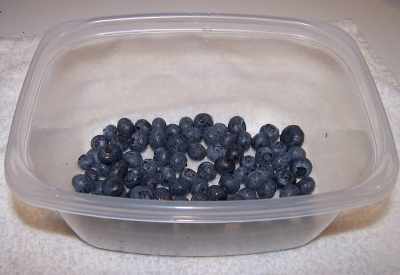 berries out in a large oven pan with a lip or ridge. Put enough on to
make 1 layer. this way they will freeze quickly and not be frozen
together in a lump, so later you can remove only what you need without
thawing the rest.
berries out in a large oven pan with a lip or ridge. Put enough on to
make 1 layer. this way they will freeze quickly and not be frozen
together in a lump, so later you can remove only what you need without
thawing the rest.
If your freezer isn't that big, just drain as much of the water as you can, then put them into whatever container will fit in your freezer. After they are frozen, they may stick together a little bit, but should break apart fairly easily.
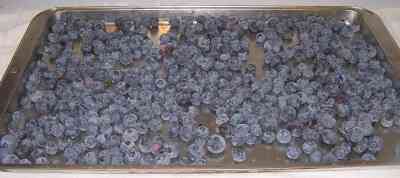
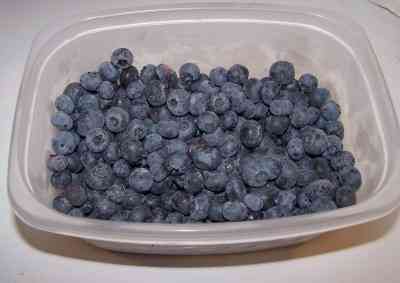
Step 5 - Put them in the freezer
Pop them into the coldest part of the freezer, or the quick freeze shelf, if your freezer has one!
I leave them in the freezer overnight, to get completely frozen.
Step 6 - Bag the saskatoons
I love the FoodSavers (see
this page for more information) with their vacuum sealing! I am
not paid by them, but these things really work. If you don't have
one, ziploc bags work, too, but it is hard to get as much air out of the
bags. remove the air to prevent drying and freezer burn.
To
the right is the same bag after vacuum sealing.
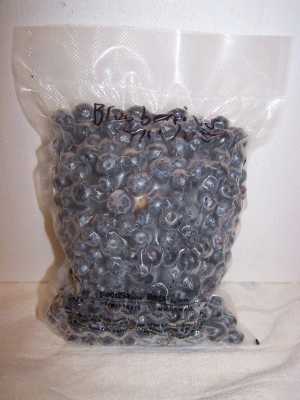
If the fruit is very wet or juicy, you can freeze the bag unsealed, upright in yourt freezer, then vacuum seal it the next day while still frozen. And while nothing works as well as the vacuum sealer; there are low budget alternatives:
To remove the excess air from a ziploc bag, put a straw inside the bag and zip it closed as far as possible. Then suck the air out of the bag, pinch the straw shut where it enters the bag and pull it from the bag and quickly zip the bag the rest of the way.
You can also submerge the bag in water up to the zip and then close it. The weight of the water pushes all the air out.."
Step 7 - Label the bags!
Of course, you will want to label them with the contents and date, or all this work could be wasted, if you can't identify them later, or don't know how old they are.
Step 8 - Done!
Pop them into the deep freeze, or in the coldest part of your regular freezer!
To use them, just set them in the fridge overnight, or on the counter for a couple of hours. I wouldn't recommend the microwave unless you are planning to cook with them!
Freezing keeps saskatoons safe to eat almost indefinitely, but the recommended maximum storage time of 12 months is best for taste and quality. The quality of the frozen saskatoons is maintained best in a very cold freezer (deep freezer), and one that keeps them frozen completely with no thaw cycles. Excluding any air from inside the bags which leads to freezer burn, by using vacuum-sealed bags, is also important to maintaining quality.
Tips:
- Harvest early in the morning, especially if the weather is hot, to get peak flavor.
- Harvest the saskatoons at its peak maturity, but not overripe and mushy.
- Process promptly after harvesting, or keep cooled in the fridge or with ice until then.
Picking Tips
[General picking tips and a guide to each fruit and vegetable] [How much do I need to pick? (Yields - how much raw makes how much cooked or frozen)] [Selecting the right varieties to pick] [All about apple varieties - which to pic
k and why!] [Picking tips for Vegetables]
[ Strawberry picking tips]
[ Saskatoons picking tips]
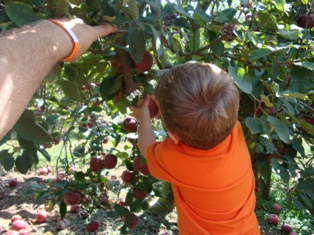
Illustrated Canning, Freezing, Jam Instructions and Recipes
[ Easy Home Canning Directions] [FAQs - Answers to common questions and problems] [Recommended books about home canning, jam making, drying and preserving!] [Free canning publications to download and print]
Looking for canning equipment and supplies?
Water bath canner with a jar rack
Pressure canners for gas, electric and induction stoves: Presto 23Qt or T-fal 22Qt
Canning scoop (this one is PERFECT)
Ball Blue book (most recent version)
Jars: 8oz canning jars for jams
Find Other types of farms:
Farm markets and roadside stands
Road trips and camping resources
Local Honey, apiaries, beekeepers
Consumer fraud and scams information
Home canning supplies at the best prices on the internet!
Maple Syrup Farms, sugarworks, maple syrup festivals
Environmental information and resources
Farms For Your Event for birthday parties, weddings, receptions, business meetings, retreats, etc.
Festivals - local fruit and vegetable festivals
Get the
most recent version of
the Ball Blue Book
With this Presto 23 quart pressure canner and pressure cooker, you can "can" everything, fruits, vegetables, jams, jellies, salsa, applesauce, pickles, even meats, soups, stews. Model 01781

You can make jams, jellies, can fruit, applesauce, salsa and pickles with water bath canners, like this Granite Ware 12-Piece Canner Kit, Jar Rack, Blancher, Colander and 5 piece Canning Tool Set

